Preparedness of Undergraduate Medical Students for Online Learning
By Tahir Ansari, Rabia Aftab, Masood AhmedAffiliations
doi: 10.29271/jcpsp.2024.03.343ABSTRACT
Objective: To determine the preparedness of the first-year undergraduate medical students toward online learning.
Study Design: Descriptive study.
Place and Duration of the Study: The study was conducted at the Department of Medical Education, Fazaia Ruth Pfau Medical College, Air University, Karachi, Pakistan, from September to December 2021.
Methodology: The study participants were first-year undergraduate medical students. A pre-validated instrument developed by Lesley University in July 2014 named 'The Prospective Online Student Readiness Questionnaire' was used. Permission was taken via email. The questionnaire has two parts. Section A consists of the demographic characteristics. Section B evaluates the student’s readiness for online learning.
Results: Data from 81 respondents were collected through an online questionnaire. The results showed that internet self-efficacy, self directed learning, learner control, and learner style have a positive and significant relationship with students' preparedness for e-learning.
Conclusion: Students are aware of the use of technology. They could be more comfortable working independently at the beginning of the course. Online environment and communication for learning purposes with peers also appear to be weak areas. Students prefer visual aids for learning, and very few enjoy raising their hands in class to answer questions. They are confident in social communications but need more confidence in using online tools for effective online communication and posting questions on online forums during discussions.
Key Words: Medical students, Online learning, preparedness, Self-efficacy, Self-directed learning.
INTRODUCTION
Online learning is described as learning experiences in syn-chronous or asynchronous environments using various devices with internet access.1 It is contextualised as broadcast teaching material to the learners through the internet. However, this is a different strategy of teaching and learning, and it is inspired by principles of pedagogy with unique features like student-centred, flexible, self-directed, and interactive.2 Online learning positively impacts students' achievements,3 satisfaction in learning experiences, self-confidence, and lifelong learning.4,5 Online learning has expanded drastically and is currently a mainstream educational method. It offers opportunities to work collaboratively and interactively with teachers and other students from various educational institutes across the world.6
Many opportunities have been opened by the current technological revolution, extensive accessibility, and constant connectivity of the internet. This has opened international learning possibilities, distance education channels, and knowledge exchange platforms. There are well-established online and distance learning programs in many affluent countries. This differs from the situation in most medical colleges in developing nations, including Pakistan.7 Despite being used extensively throughout the world, most educational institutions in Pakistan have never integrated online learning into formal education.8 There was a change in situation when all public and private educational institutions in Pakistan, like many other nations around the world, were instructed by regulatory bodies to conduct all of their teaching and learning activities online until the spread of COVID-19 slowed down.9,10
There are two stakeholders of online learning, the technology and the learner itself. Technology has been essential for the development of online learning. It is necessary to have various tools that deal with information exchange and help in communication. These tools can be a desktop computer, laptop, smartphone, or other smart device, an internet connection, and online learning platforms.11,12 However, it requires a certain level of technical skills and expertise for online learning from users. Students must be somewhat prepared at least to get the most out of this online learning style. This has raised the question of whether Pakistani undergraduate medical students are ready and equipped to adopt online learning and successfully navigate its barriers. This study was designed to determine the level of readiness for online learning of undergraduate medical students in one of the private medical colleges in Karachi, Pakistan.
METHODOLOGY
This study used a descriptive research design. The participants were first-year medical students at the Fazaia Ruth Pfau Medical College (FRPMC), Karachi. Non-probability convenient samp-ling was used. The total number of students was 100 and only those students who voluntarily participated in the study were included. The students who were absent throughout the sessions were excluded. The study took place in September 2021. A pre-validated instrument developed by Lesley University in July 2014 named 'The Prospective Online Student Readiness Questionnaire' was used. The permission from Lesley University to use the instrument was taken through email. The questionnaire has two parts: Section A determines the demographic characteristics, and Section B determines the student's preparedness for online learning and is grouped into five categories: Computer/internet self-efficacy, self-directed learning, learner control, learning styles, and online communication self-efficacy. The research and ethics board of the FRPMC approved the study (Protocol number: FRPMC-003). Before the beginning of the survey, the participants were given full disclosure about the study. The consent form was filled from all the participants.
SPSS version 22 was used for data analysis. The selected participants were sent a survey questionnaire through email. Only 81 participants responded to the questions. After all the responses were collected, the data were analysed using descriptive analysis.
RESULTS
A total of 100 questionnaires were emailed to the participants. Out of which, only 81 participants responded. The demographic results are shown in Table I:
In the computer self-efficacy category, seven questions were asked. Results showed that participants were comfortable using the internet, as reported by 51 (63%) students. Sixty-eight (84%) students were able to use search engines to research information, 65 (80%) students used technology to communicate, 64 (79%) students
had used web browsers and chat programs, and 63 (77%) students could load and install new programs. Figure 1 presents the participants’ responses toward internet self-efficacy.
In the self-directed learning category, seven questions were asked. The results showed that 61 (75%) students enjoyed interacting with classmates individually or in group projects. Fifty seven (70.4%) students made notes from viewing audios or videos and turned in assignments on time without reminders. Figure 2 presents the participants’ experience with self-directed learning during online education.
In the learner control category, seven questions were asked. The results showed that 72 (88.9%) students found writing and reading in English easy.
Table I: The demographics of study participants.
|
Variables |
n |
Percentage (%) |
|
Gender |
- |
- |
|
Male |
27 |
33.3396 |
|
Female |
54 |
66.67% |
|
Students' age in consolidate form |
- |
- |
|
18 years old |
2 |
2.47% |
|
19 years old |
27 |
33.3391 |
|
20 years old |
44 |
54.3296 |
|
21 years old |
6 |
7.41% |
|
22 years old |
1 |
1.2396 |
|
23 years old |
1 |
1.2396 |
|
Education system Adopted for HSC |
- |
- |
|
Intermediate Board |
73 |
90_12% |
|
Cambridge System |
8 |
9.8896 |
|
Have own desktop / tablet / laptop |
- |
- |
|
Yes |
76 |
93.8396 |
|
No |
5 |
6_1796 |
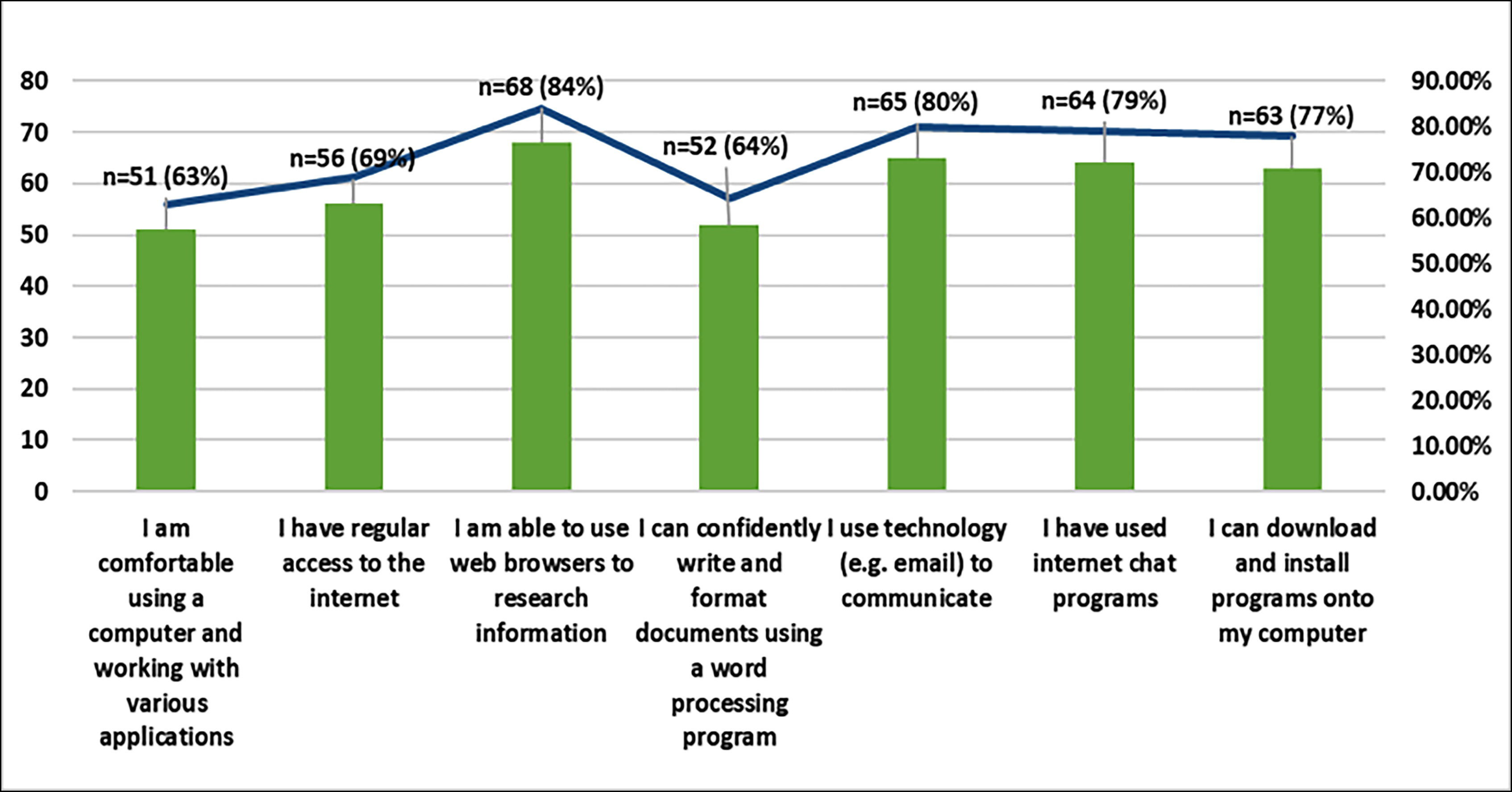 Figure 1: Computer/internet efficacy.
Figure 1: Computer/internet efficacy.
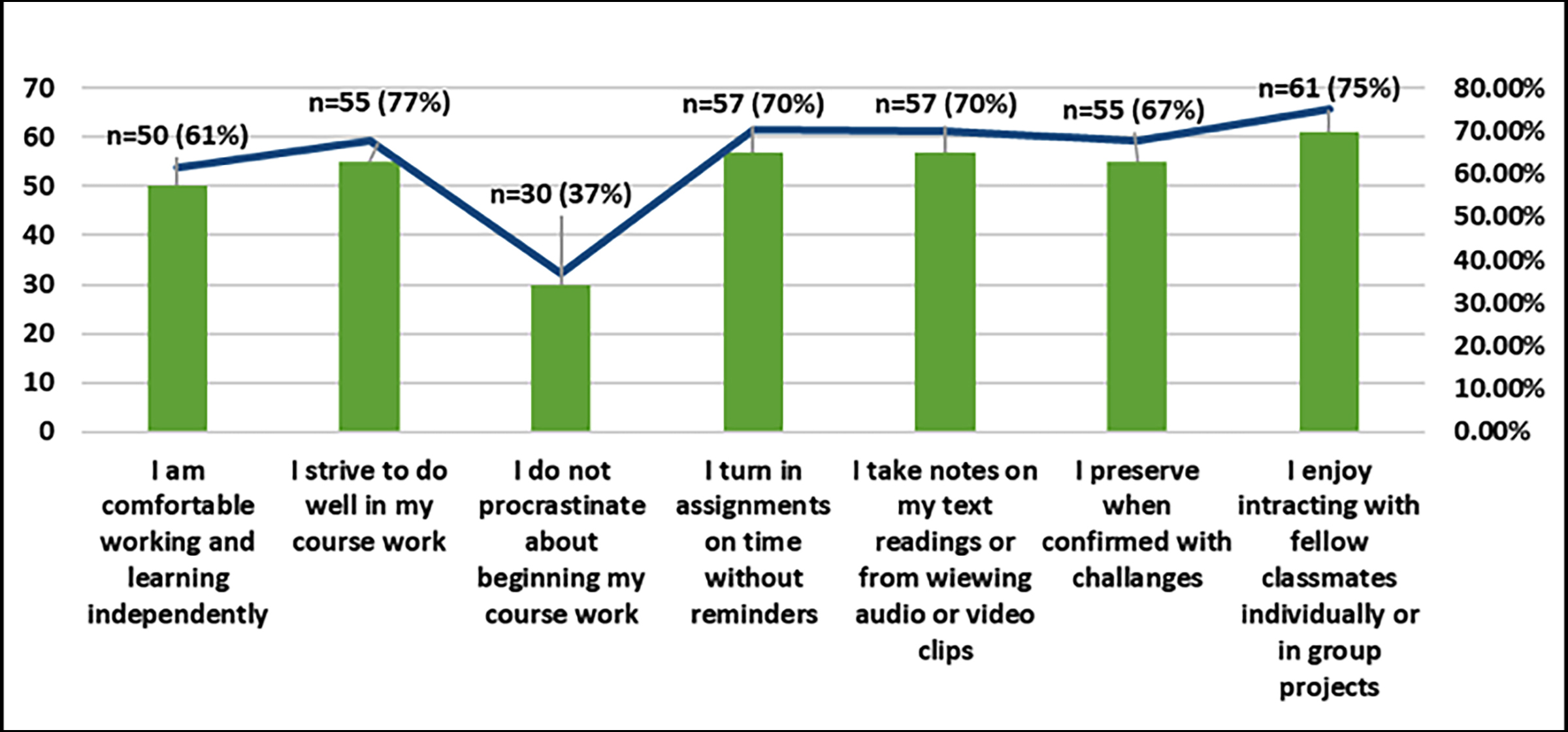 Figure 2: Self-Directed learning.
Figure 2: Self-Directed learning.
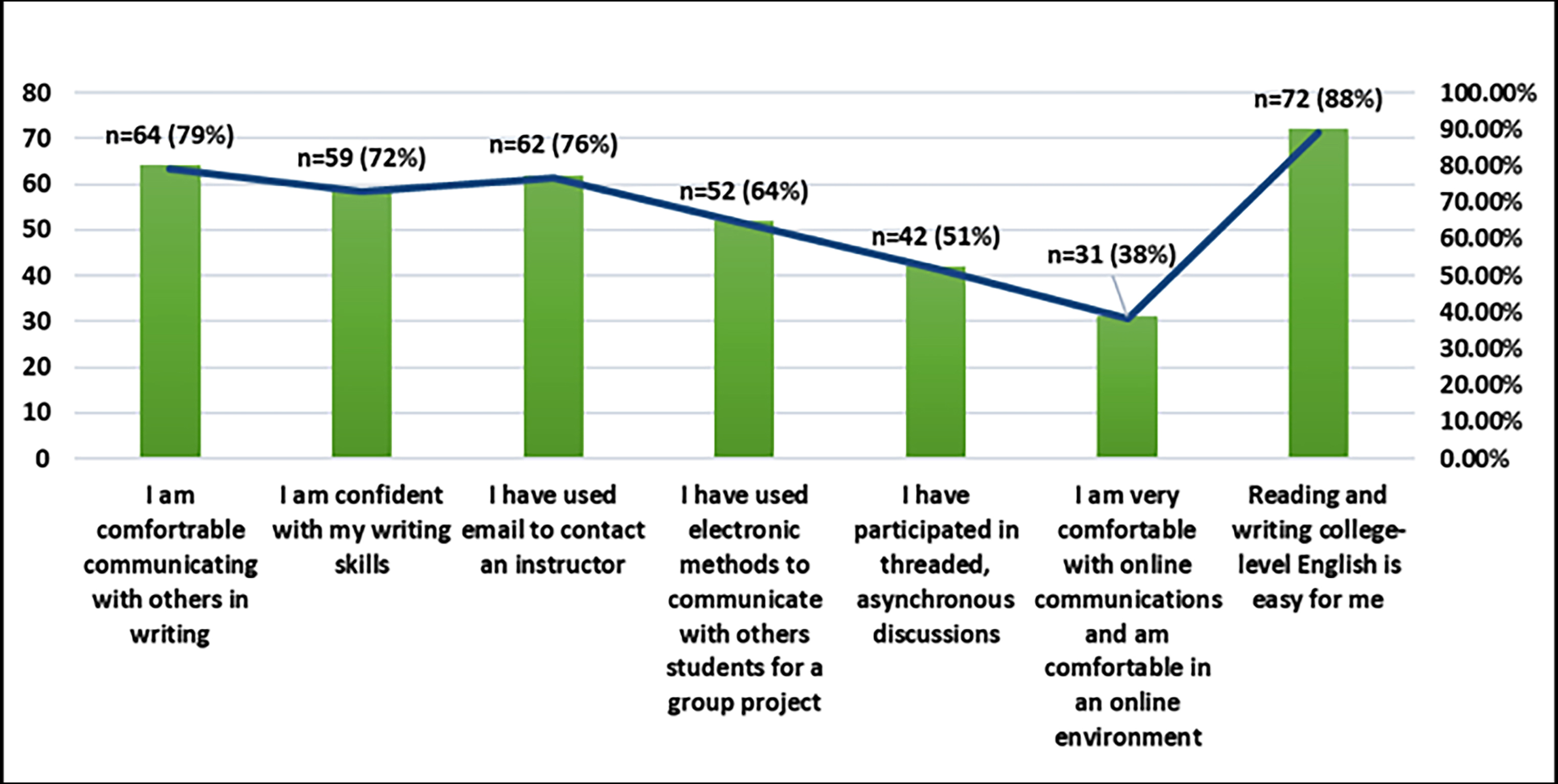 Figure 3: Learner control.
Figure 3: Learner control.
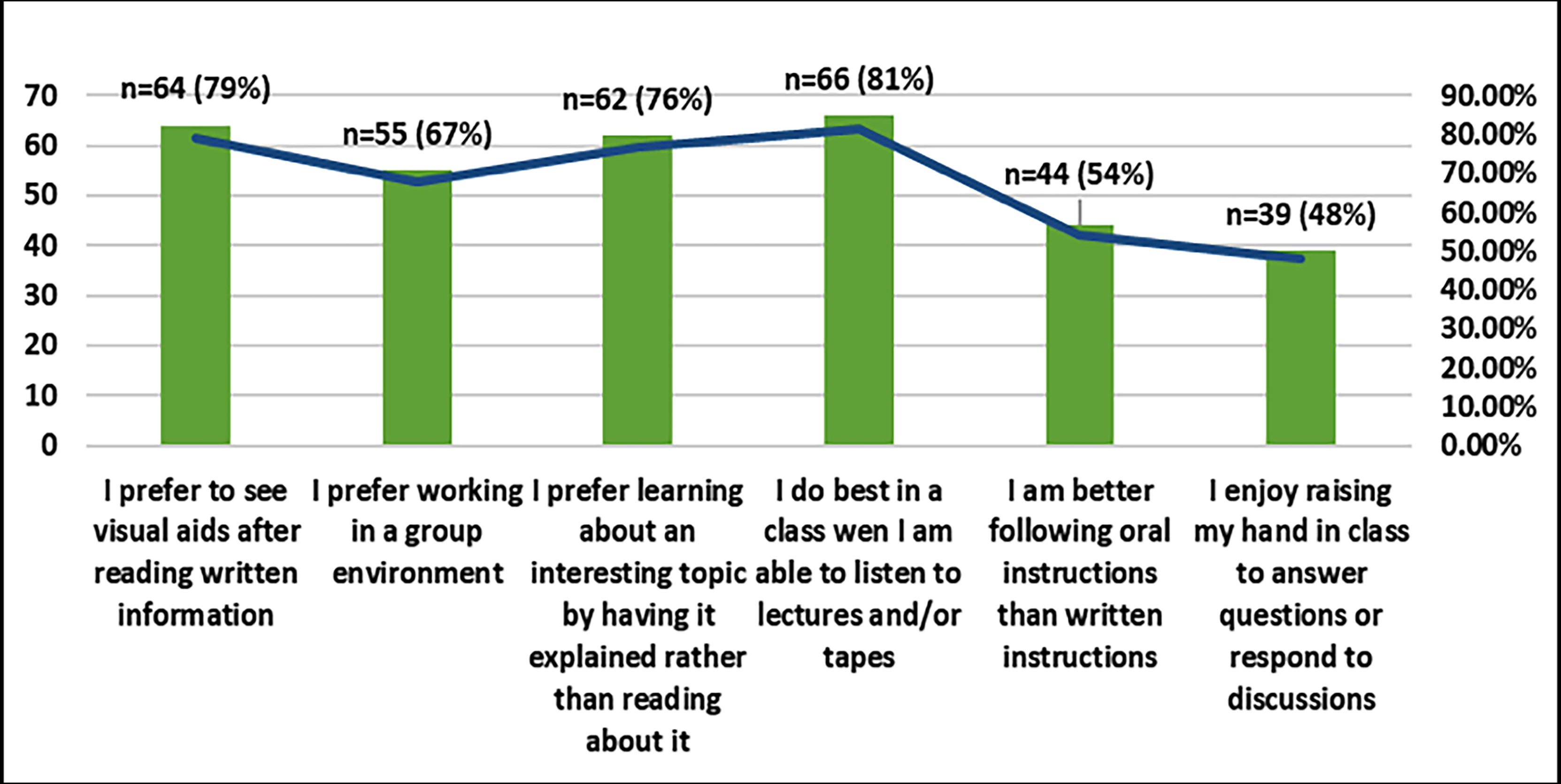 Figure 4: Learning styles.
Figure 4: Learning styles.
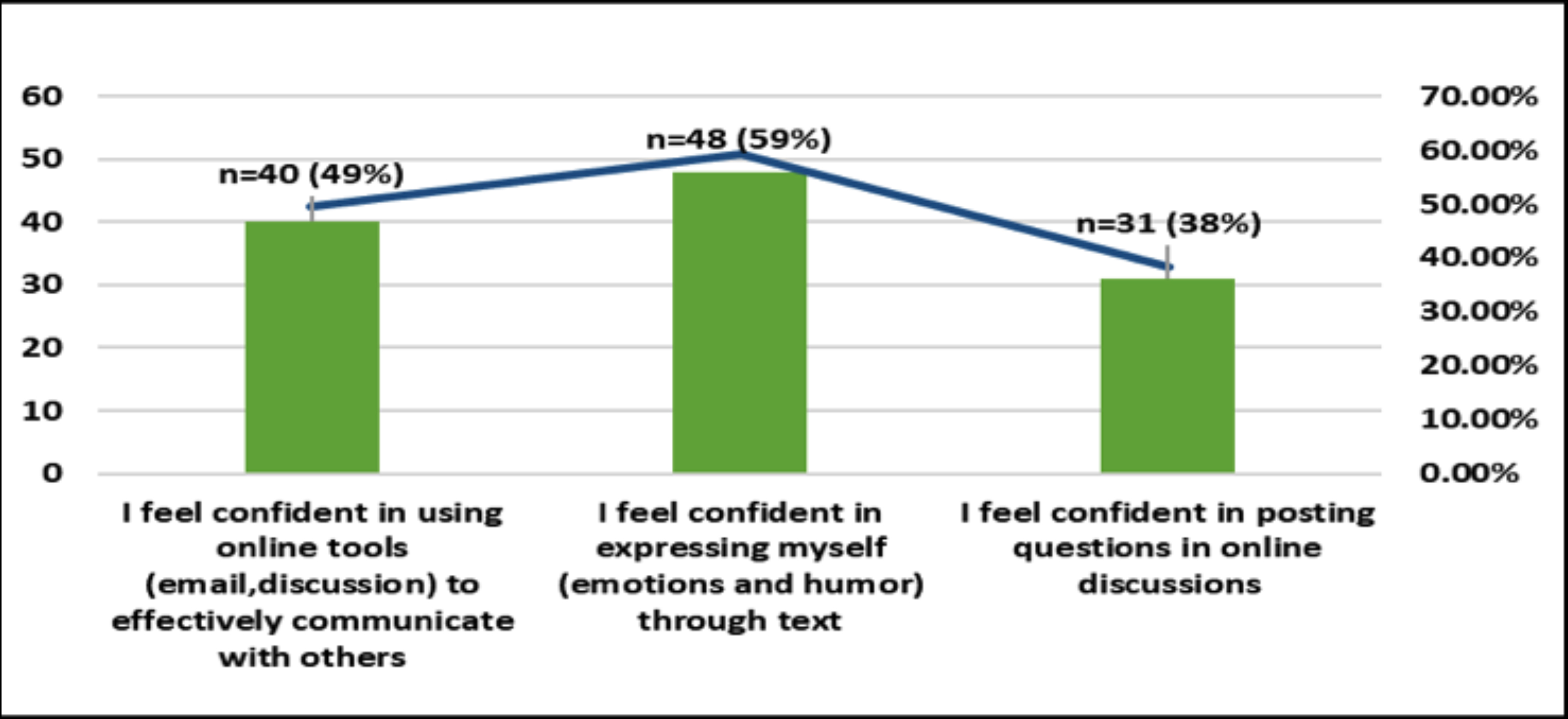 Figure 5: Online communication self-efficacy
Figure 5: Online communication self-efficacy
It was convenient for 64 (79%) students of the students to communicate with others in writing, 59 (72%) students were optimistic about their writing skills, and 62 (76.5%) students used email to contact any instructor. Figure 3 presents the participants’ experience with learner control.
In the learning styles category, six questions were asked. The results showed that 66 (81%) students did best in the class when listening to the lectures or recorded lectures. Sixty-four (79%) students preferred visual aids after reading written information. Figure 4 presents the participants’ experiences with learning style.
In online communication self-efficacy, three questions were asked. Results showed that only 40 (49%) students felt optimistic about utilising online learning tools to communicate effectively with others. Thirty-one (38%) students felt confident about posting questions in online discussions, and 48 (59%) confidently expressed themselves during online classes. Figure 5 presents the participants’ experiences with online communication self-efficacy.
DISCUSSION
This study shows that undergraduate medical students have a high level of preparedness in computer self-efficacy, followed by self-directed learning and learner control. It was lowest in the area of online communication self-efficacy.
From the findings, it can be deduced that students are confident in their skills in using computer technology and web browsers. Medical students are generally skilled in using computer technology due to their technology-rich surroundings.13 These skills include using different web browsers, searching for relevant online information, and using MS Excel, MS PowerPoint, and other online learning software. These are essential skills to increase students' preparedness for online learning.14 The findings are similar to other research studies concluding that computer self-efficacy was necessary for e-learning and was significantly associated with students' online learning success.15,16
The findings in the domain of self-directed learning revealed that students enjoy interacting with classmates and taking notes while viewing audio or video clips but are less comfortable working and learning independently. Self-directed learning is a learning methodology that allows students to take control of their learning actions. They establish study goals and link resources for learning. They also choose and implement strategies convenient to them and assess the learning outcomes.17
Learner control has been studied for more than half a century. Still, a clear definition or theory has yet to be developed due to its multidimensional characteristics.18 Learner control is the extent to which students can choose how, what, and when to learn.19 In this study, learner control included reading and writing skills, learning with peers, and using email to communicate. The majority of the students found writing and reading in English easy. Students need to be more comfortable with online environments and communication with peers. Learner control is the lower-rated dimension of online learning readiness among learners as compared to other dimensions.20
Learning style is how each student initiates the focus process and retains new and strenuous information. By identifying each student's learning style, the students and instructors can have valuable knowledge about factors influencing learning. With an increased diversity of students, instructors can design new and alternative learning strategies to increase student motivation and interest.21 The findings in this domain revealed that most students preferred a learning style in which they see visual aids after reading written information. Few students enjoy raising their hands in class to answer any questions.
The results in online communication self-efficacy have shown lower mean scores compared to the other domains. Although socially, students are confident in expressing themselves through text but need more confidence in using online tools for effective online communication. They also need to be more confident in posting questions on online forums during a discussion. This is similar to other studies that concluded that students are generally comfortable expressing themselves in writing.22 There is an interesting finding from this study that students' preparedness for the internet and computers is high but it is low towards effective online communication. This finding is similar to previous research concluding that online communication self efficacy is essential to promote online learning for students.23 On the contrary, another study found that the online communication self-efficacy of students was comparatively less essential.24 The low scores in this domain clearly indicate that undergraduate medical students need more attention and strategies for improving confidence in online communication.
In this study, theoretical framework was used, based on the online collaborative learning (OCL) theory, proposed by Linda Harasim, that emphasizes the facilities of the internet to provide a conducive learning environment. It also promotes collaboration and knowledge building. This theory derives from social constructivism, as students are provided opportunities to collaborate and solve problems. The teachers play the role of facilitator as well as learning community members.24
CONCLUSION
The findings from this study show that learners (first-year MBBS students) are well aware of the use of technology. They are less comfortable in beginning coursework and working independently. Online environment and communication for learning purposes with peers also appear to be weak areas. Students prefer visual aids for learning, and very few enjoy raising their hands in class to answer questions. They are confident in social communications but need more confidence in using online tools for effective online communication and posting questions on online forums during discussions. There is a dire need for planning and implementing activities empowering students to use online tools for teaching and learning, providing them with platforms where they can interact with peers for educational collaboration, and incorporating audio-visual aids during online classes. Follow-up studies are needed to measure the outcome of e-learning activities on students' academic performance.
ETHICAL APPROVAL:
The research and ethics board of the FRPMC approved the study (Protocol number: FRPMC-003).
PARTICIPANTS’ CONSENT:
The consent form was filled from all the participants.
COMPETING INTEREST:
The authors declared no competing interest.
AUTHORS’ CONTRIBUTION:
TA: Conception, design of the work, and drafting of the manu-script.
RA: Acquisition, analysis, and interpretation of data.
MA: Final review of the version to be published.
All authors approved the final version of the manuscript to be published.
REFERENCES
- Singh V, Thurman A. How many ways can we define online learning? A systematic literature review of definitions of online learning (1988-2018). Am J Dist Educ 2019; 33(4): 289-306. doi:10.1080/08923647.2019.1663082.
- Mynbayeva A, Sadvakassova Z, Akshalova B. Pedagogy of the twenty-first century: Innovative teaching methods. New pedagogical challenges in the 21st century. Contributions of Research in Education 2018. doi:10.5772/intechopen. 72341.
- Engin M. Analysis of students’ online learning readiness based on their emotional intelligence level. Univers J Educ Res 2017; 5(12A):32-40. doi: 10.13189/ujer.2017.051306.
- Bernard RM, Brauer A, Abrami PC, Surkes M. The develop-ment of a questionnaire for predicting online learning achievement. Distance Educ 2004; 25(1): 31- 47. doi:10. 1080/0158791042000212440.
- Poole DM. Student participation in a discussion-oriented online course: A case study. J Res Comput Educ 2000; 33(2):162-77. doi:10.1080/08886504.2000.10782307.
- Jones C. Networked learning, stepping beyond the net generation and digital natives. In: Dirckinck-Holmfeld L, Hodgson V, Mc Connell D, Eds. Exploring the Theory, Pedagogy, and Practice of Networked Learning. Springer, New York; 2012:p. 27-41. doi:10.1007/ 978-1- 4614-0496-5_2.
- Nawaz A. E-Learning experiences of HEIs in advanced states, developing countries, and Pakistan. Univers J Educ Gen Stud 2012; 1(3):72-83.
- Abbasi S, Ayoob T, Malik A, Memon SI. Perceptions of students regarding E-learning during Covid-19 at a private medical college. Pak J Med Sci 2020; 36 (COVID19-S4): S57-S61. doi: 10.12669/pjms.36.COVID 19-S4.2766.
- Rafique GM, Mahmood K, Warraich NF, Rehman SU. Readiness for Online Learning during COVID-19 pandemic: A survey of Pakistani LIS students. J Acad Librariansh 2021; 47(3):102346. doi: 10.1016/j.acalib. 2021.102346.
- Rehman AU, Khan B. Challenges to online education in Pakistan during COVID-19 & the way forward. Soc Sci Learn Educ J 2021; 6(07):503-12. doi:10.15520/sslej. v6i07.2829.
- Dhawan S. Online learning: A panacea in the time of COVID-19 crisis. J Educ Technol 2020; 49(1):5-22. doi: 10.1177/0047239520934018.
- Turnbull D, Chugh R, Luck J. Transitioning to E-Learning during the COVID-19 pandemic: How have higher education institutions responded to the challenge? Educ Inf Technol 2021; 26(5):6401-19. doi: 10.1007/s10639- 021-10633-w.
- Hung ML, Chou C, Chen CH, Own ZY. Learner readiness for online learning: Scale development and student perceptions. Comput Educ 2010; 55(3):1080-90. doi:10. 1016/j.compedu.2010.05.004.
- Knowles MS. Self-directed learning: A guide for learners and teachers. New York: Associations Press;1975.
- Alqurashi E. Self-efficacy in online learning environ-ments: A literature review. Contemporary Issues Educ Res 2016; 9(1):45-52. doi:10.19030/cier.v9i1.9549.
- Tsai CL, Cho MH, Marra R, Shen D. The self-efficacy questionnaire for online learning (SeQoL). Distance Educ 2020; 41(4):472-89. doi:10.1080/01587919. 2020.1821 604.
- DeRouin RE, Fritzsche BA, Salas E. Learner control and workplace e-learning: Design, person, and organizational issues. Hum Resour Manage 2005; 24:181-214. doi:10. 1016/S0742-7301(05)24005-7.
- Kraiger K, Jerden E. A meta-analytic investigation of learner control: Old findings and new directions. In: Fiore SM, Salas E, Eds. Toward a Science of Distributed Learning (pp. 65–90). American Psychological Asso-ciation 2007. doi: 10. 1037/11582-004
- Dunn R, Sklar RI, Beaudry J, Bruno J. Effects of matching and mismatching minority developmental college students’ hemispheric preferences on mathematics scores. J Educ Res 1990; 83(5):283-8. doi: 10.1080/00220671.1990.1088 5971.
- Naji KK, Du X, Tarlochan F, Ebead U, Hasan MA, Al-Ali AK. Engineering Students' readiness to transition to emergency online learning in response to COVID-19: Case of Qatar. EURASIA J Math Sci Tech Ed 2020; 16(10):em1886. doi: 10.29333/ejmste/8474.
- Saade RG, He X, Kira D. Exploring dimensions to online learning. Comput human behavior 2007; 23(4):1721-39. doi:10.1016/j.chb.2005.10.002.
- Picciano AG. Theories and frameworks for online education: Seeking an integrated model. Online Learning 2017; 21(3):79-103. doi:10.24059/olj.v21i3.1225.
- Yasin NM, Ong MH, Utmspace UT. A blended learning model of technology access and technical self-efficacy: Multiple mediator effects on student readiness. J Dyn Control Syst 2020; 12(3):531-9. doi:10.5373/JARDCS/V12I3/20201220.
- Estira KL. Online distance learning readiness of business administration students in one state university in the Philippines. J Crit Rev 2020; 7(12):826-32. doi:10.31838/ jcr.07.12.146.